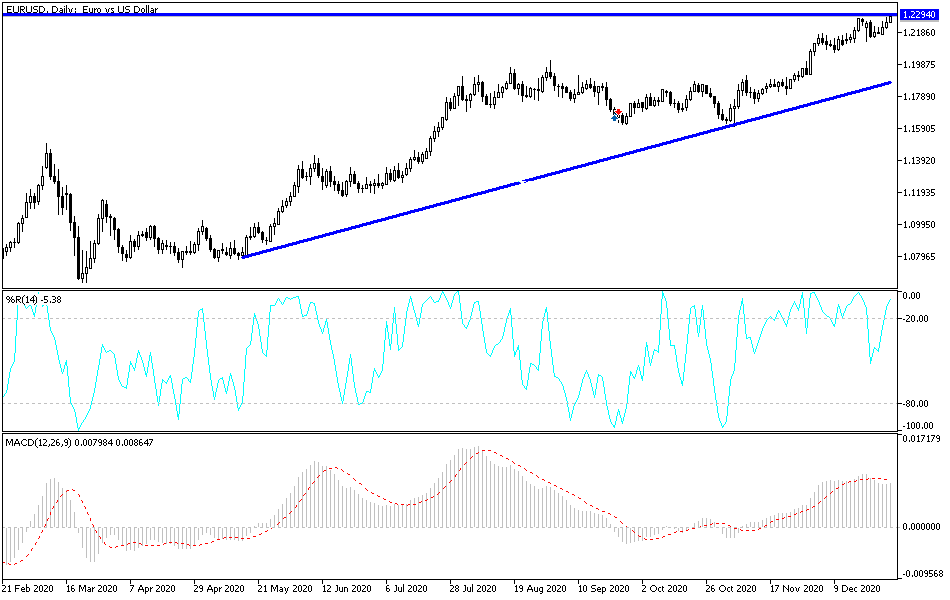Investors have recently abandoned the US dollar as a safe haven, which coincides with the strong rise in the coronavirus cases and the beginning of global vaccinations, as well as Trump's reactions to the economic stimulus plans. The opportunity became better for the EUR/USD pair to maintain its gains and even break through the recent peaks that pushed it towards its highest level since April 2018. The pair is stable around the top of 1.2295 as of this writing. In general, the euro is on its way to end 2020 supported by nearly double-digit gains against the dollar, which has depreciated, but it will face a range of risks in 2021 and beyond, including the coronavirus, which increasingly threatens to reinforce doubts about the euro’s gains.
The bullish expectations for the EUR/USD currency pair are still high, in anticipation of the global economic recovery that favours exporting countries and their currencies, as well as further contraction of the USD. However, euro policy officials may ignore the possibility of a sharp rise in suspicion of the euro within the Eurozone’s largest economy and financial sponsor, Germany, which has federal elections scheduled for September 2021 that may act as a wake-up call. Especially since the last occasion when voters had the opportunity to express their views in this way, the ECB's monetary policy will likely become a greater concern for any Germans inclined to question Europe. The European Central Bank has significantly increased its footprint in the Eurozone government bond market since the September 2017 federal election and is set to continue to do so for a while.
“The European Central Bank recently pledged €1 trillion in quantitative easing between now and the first quarter of 2022, which is likely enough to absorb around 80% of the net sovereign bond issuance during the same period,” says Klaus Festissen, chief Eurozone economist at Pantheon Macroeconomics. “The European Central Bank, in one way or another, explicitly adjusts its asset purchases to the pace of government debt issuance, therefore, it is difficult to imagine a political backlash against financial and monetary support at this stage, but not that it might change in the end.”
At the time of the most recent elections, the European Central Bank owned an estimated 17.5% of the Eurozone government debt market, but it placed a clear plan for a steady liquidation of the quantitative easing program, which was responsible for adding bonds to its balance sheet. This was a failed attempt to stimulate the economy to achieve a near 2% inflation target that has eluded the European Central Bank since the debt crisis.
In June 2017, the European Central Bank hinted at plans to scale back its controversial program to buy bonds while the minutes of its last meeting before the September elections in Germany confirmed that it was in fact planning to end purchases later that year. The program ended successfully, but unfortunately it was forced in September 2019 to resume purchases in response to subdued economic growth and dwindling inflation pressures.
But the resumption of quantitative easing in 2019 and the unprecedented economic turmoil of 2020 has now seen the bank's government debt holdings grow to €3.01 trillion, equivalent to nearly 30% of available supply. By the time Germans head to the polls in September 2021, the bank is expected to hold nearly 4 trillion euros of Eurozone government bonds on its balance sheet. Also, increasingly, these bonds will be those issued by the Mediterranean countries that were often painted and viewed as corrupt in the past.
According to the technical analysis of the pair:
On the daily chart, the general trend of the EUR/USD currency pair remains upward, and testing the resistance levels at 1.2300, 1.2375 and 1.2465 will push the technical indicators to strong oversold areas, from which profit-taking may be considered. Despite the current activity in the market, it lacks full liquidity ahead of the New Year holidays. On the downside, the bears will not be in control of the performance without breaking the 1.2000 support.
In addition to investors’ risk appetite, the currency pair will interact with US data, including the commodity trade balance, pending home sales and the Chicago PMI.



